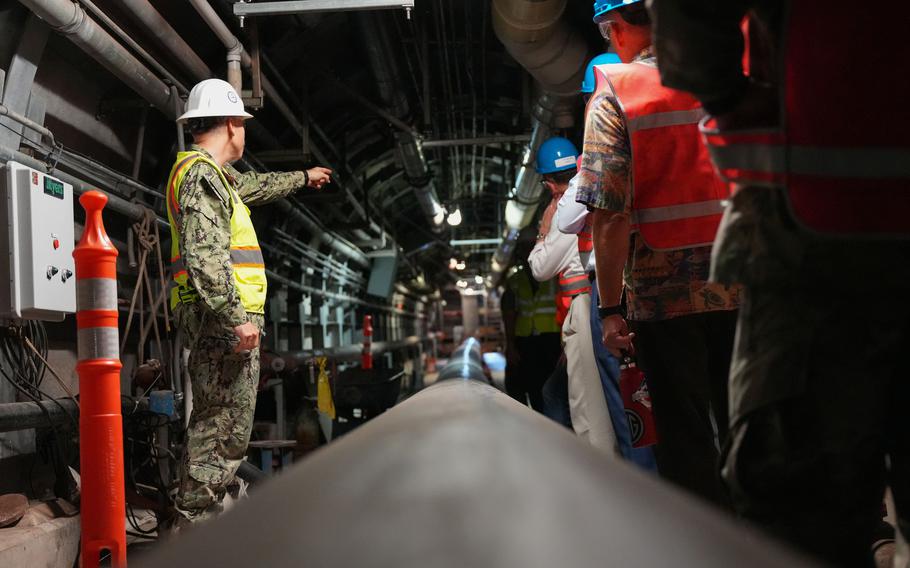
Navy Capt. Shawn Triggs, left, fuels director with Joint Task Force-Red Hill, briefs Department of Defense Inspector General Robert Storch during a tour of the Red Hill Bulk Fuel Storage Facility in Hawaii in June 2023. (Nicholas Brown/Department of Defense)
FORT SHAFTER, Hawaii — Navy officials did not effectively manage operations, maintenance, safety and oversight in accordance with policy and federal and state laws at the now-defunct Red Hill fuel facility in Hawaii, according to a pair of Department of Defense reports released recently.
A fuel leak at the facility in late 2021 contaminated the Navy’s water distribution used by military communities on and near Joint Base Pearl Harbor-Hickam. The disaster has been an expensive one, according to a news release Thursday from the DOD Inspector General’s Office.
The DOD spent more than $220 million responding to the 2021 contamination incident, the news release states. The National Defense Authorization Acts for fiscal years 2022 and 2023 included more than $2.1 billion in funding related to the water contamination and the facility’s closure.
Thousands were forced to relocate for months to area hotels as the Navy flushed the system. Some residents reported a host of maladies in the wake of the spill, such as rashes, headaches, gastrointestinal issues, anxiety and depression.
Defense Secretary Lloyd Austin in March 2022 ordered the World War II-era underground storage facility to be permanently closed. The process of emptying and cleaning the 20 massive tanks and cleaning up the soil surrounding the facility will take years.
One of the Navy’s wells remains contaminated with jet fuel.
The two IG reports stated that risks inherent at the facility were well documented and that incident response plans to mitigate them existed.
“However, the DoD OIG also found that Navy officials did not follow the basic tenets of their incident response plans or meet the reporting requirements for fuel incidents,” the news release states.
“Furthermore, the incident response plans were insufficient,” the release states.
Navy officials “did not consistently analyze trends in the fuel inventory to prevent, identify, and respond to potential or actual fuel incidents.
“It is imperative that the Navy address ongoing challenges with the management of fuel and water systems at Joint Base Pearl Harbor-Hickam,” Inspector General Robert P. Storch said in the release.
“Although the Red Hill Bulk Fuel Storage Facility was defueled and the DoD intends to close it permanently, the fueling operations at Naval Station Pearl Harbor and Hickam Air Force Base remain in operation,” he said.
“Moreover, the Joint Base Pearl Harbor–Hickam Community Water System continues to provide drinking water to Service members, their families, and members of the public,” he said. “Unless the DoD mitigates critical infrastructure issues, the readiness of Service members, the well-being of their families, and the environment are at risk.”
Among the IG’s 16 recommendations are that the DOD assesses leak detection systems at all Navy fueling points.
The recommendations build upon those made in previous reports by the U.S. Environmental Protection Agency and the Agency for Toxic Substances and Disease Registry, as well as command investigations by the Vice Chief of Naval Operations and the Naval Facilities Engineering Systems Command.
Hawaii’s congressional delegation, which requested an IG investigation almost three years ago, on Thursday called on the Navy to fully implement the recommendations.
“The Navy must take full responsibility for its failures and immediately implement the recommendations from the Inspector General in order to address the ongoing impacts to public health and the environment,” the delegation said in a news release.
“These independent reports make clear that for decades the Navy and the Department of Defense have failed to manage fuel and water operations at Red Hill and across Joint Base Pearl Harbor-Hickam to a standard that protects the health and safety of the people of Hawai‘i.
“It’s outrageous and unacceptable.”